The Impact of Change on Educational Leadership and Mentoring
VerifiedAdded on 2023/06/08
|34
|10152
|489
Essay
AI Summary
This essay delves into the multifaceted aspects of educational leadership and change management, emphasizing their critical roles in fostering institutional efficiency and stakeholder engagement. The paper explores the evolution of educational leadership, particularly in the context of the UAE, and analyzes the impact of cultural factors on leadership styles. It investigates the relationship between leadership and change management, examining policy approaches and theoretical frameworks such as Lewin's change model. Furthermore, the essay addresses the practical challenges leaders face, the importance of mentoring initiatives, and their benefits in enhancing professional and personal competence, with a focus on transformational leadership. The paper concludes with recommendations for improving mentoring practices to support effective leadership in educational settings. This comprehensive analysis aims to provide insights into navigating the complexities of educational change and leadership.
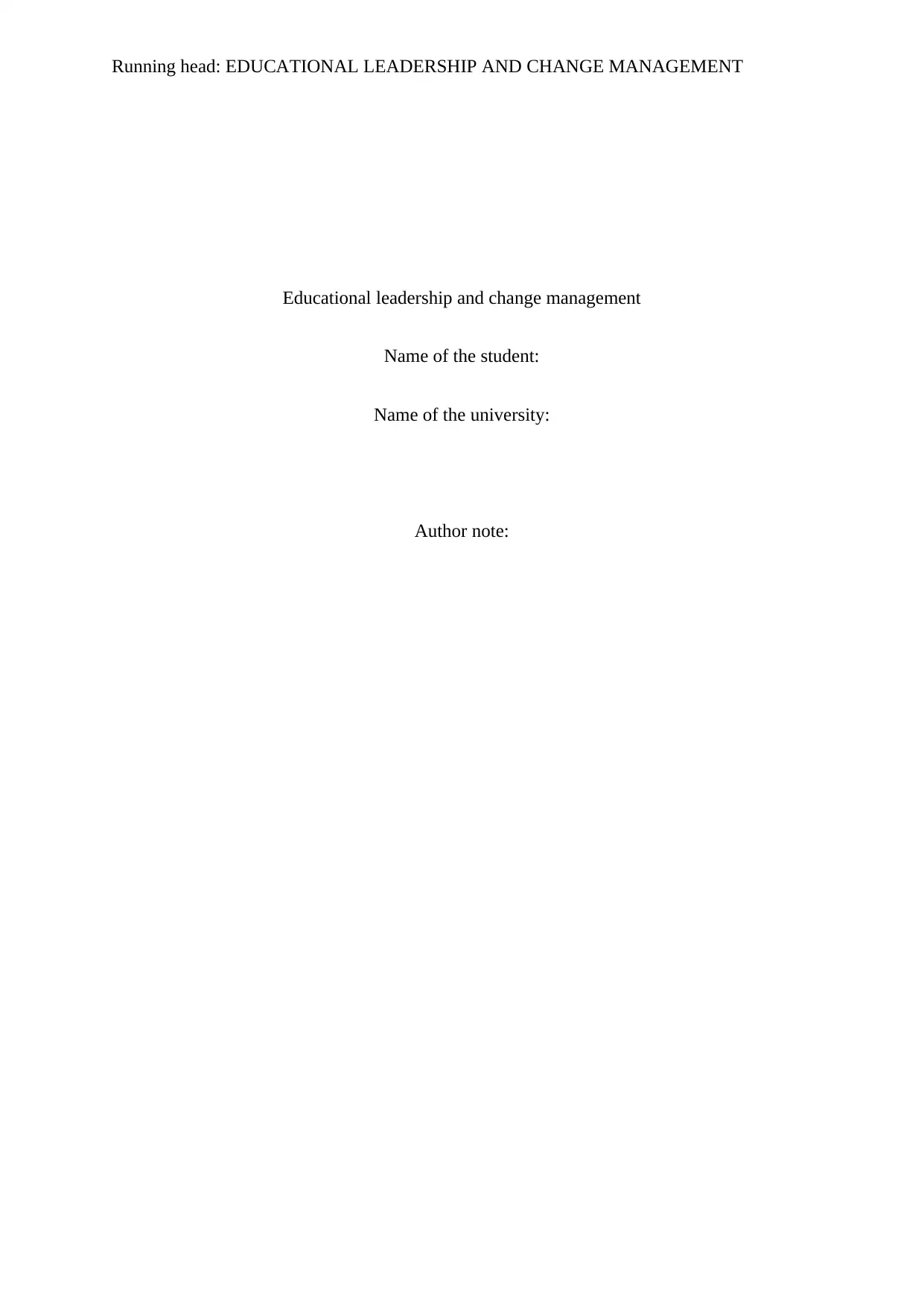
Running head: EDUCATIONAL LEADERSHIP AND CHANGE MANAGEMENT
Educational leadership and change management
Name of the student:
Name of the university:
Author note:
Educational leadership and change management
Name of the student:
Name of the university:
Author note:
Paraphrase This Document
Need a fresh take? Get an instant paraphrase of this document with our AI Paraphraser
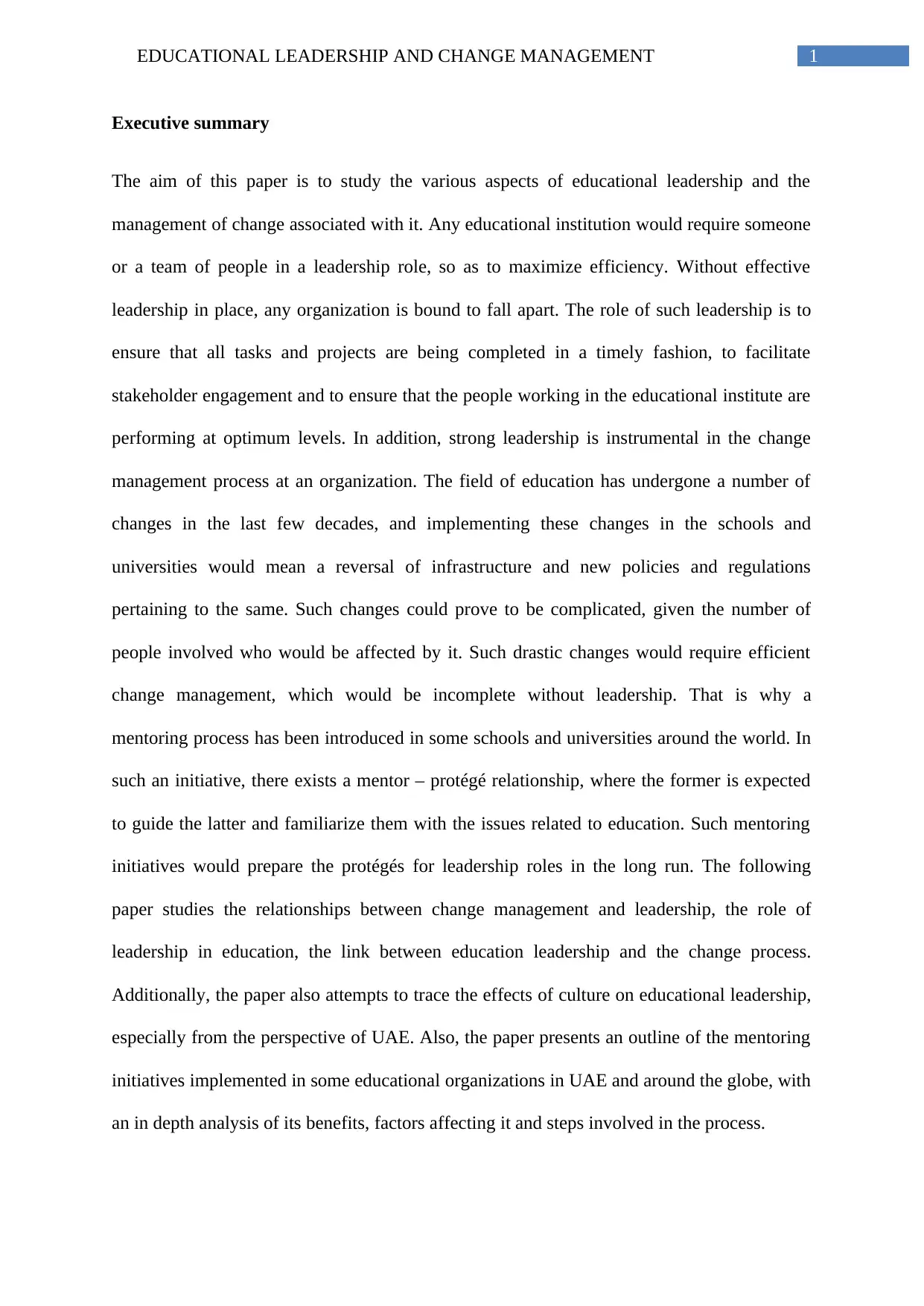
1EDUCATIONAL LEADERSHIP AND CHANGE MANAGEMENT
Executive summary
The aim of this paper is to study the various aspects of educational leadership and the
management of change associated with it. Any educational institution would require someone
or a team of people in a leadership role, so as to maximize efficiency. Without effective
leadership in place, any organization is bound to fall apart. The role of such leadership is to
ensure that all tasks and projects are being completed in a timely fashion, to facilitate
stakeholder engagement and to ensure that the people working in the educational institute are
performing at optimum levels. In addition, strong leadership is instrumental in the change
management process at an organization. The field of education has undergone a number of
changes in the last few decades, and implementing these changes in the schools and
universities would mean a reversal of infrastructure and new policies and regulations
pertaining to the same. Such changes could prove to be complicated, given the number of
people involved who would be affected by it. Such drastic changes would require efficient
change management, which would be incomplete without leadership. That is why a
mentoring process has been introduced in some schools and universities around the world. In
such an initiative, there exists a mentor – protégé relationship, where the former is expected
to guide the latter and familiarize them with the issues related to education. Such mentoring
initiatives would prepare the protégés for leadership roles in the long run. The following
paper studies the relationships between change management and leadership, the role of
leadership in education, the link between education leadership and the change process.
Additionally, the paper also attempts to trace the effects of culture on educational leadership,
especially from the perspective of UAE. Also, the paper presents an outline of the mentoring
initiatives implemented in some educational organizations in UAE and around the globe, with
an in depth analysis of its benefits, factors affecting it and steps involved in the process.
Executive summary
The aim of this paper is to study the various aspects of educational leadership and the
management of change associated with it. Any educational institution would require someone
or a team of people in a leadership role, so as to maximize efficiency. Without effective
leadership in place, any organization is bound to fall apart. The role of such leadership is to
ensure that all tasks and projects are being completed in a timely fashion, to facilitate
stakeholder engagement and to ensure that the people working in the educational institute are
performing at optimum levels. In addition, strong leadership is instrumental in the change
management process at an organization. The field of education has undergone a number of
changes in the last few decades, and implementing these changes in the schools and
universities would mean a reversal of infrastructure and new policies and regulations
pertaining to the same. Such changes could prove to be complicated, given the number of
people involved who would be affected by it. Such drastic changes would require efficient
change management, which would be incomplete without leadership. That is why a
mentoring process has been introduced in some schools and universities around the world. In
such an initiative, there exists a mentor – protégé relationship, where the former is expected
to guide the latter and familiarize them with the issues related to education. Such mentoring
initiatives would prepare the protégés for leadership roles in the long run. The following
paper studies the relationships between change management and leadership, the role of
leadership in education, the link between education leadership and the change process.
Additionally, the paper also attempts to trace the effects of culture on educational leadership,
especially from the perspective of UAE. Also, the paper presents an outline of the mentoring
initiatives implemented in some educational organizations in UAE and around the globe, with
an in depth analysis of its benefits, factors affecting it and steps involved in the process.
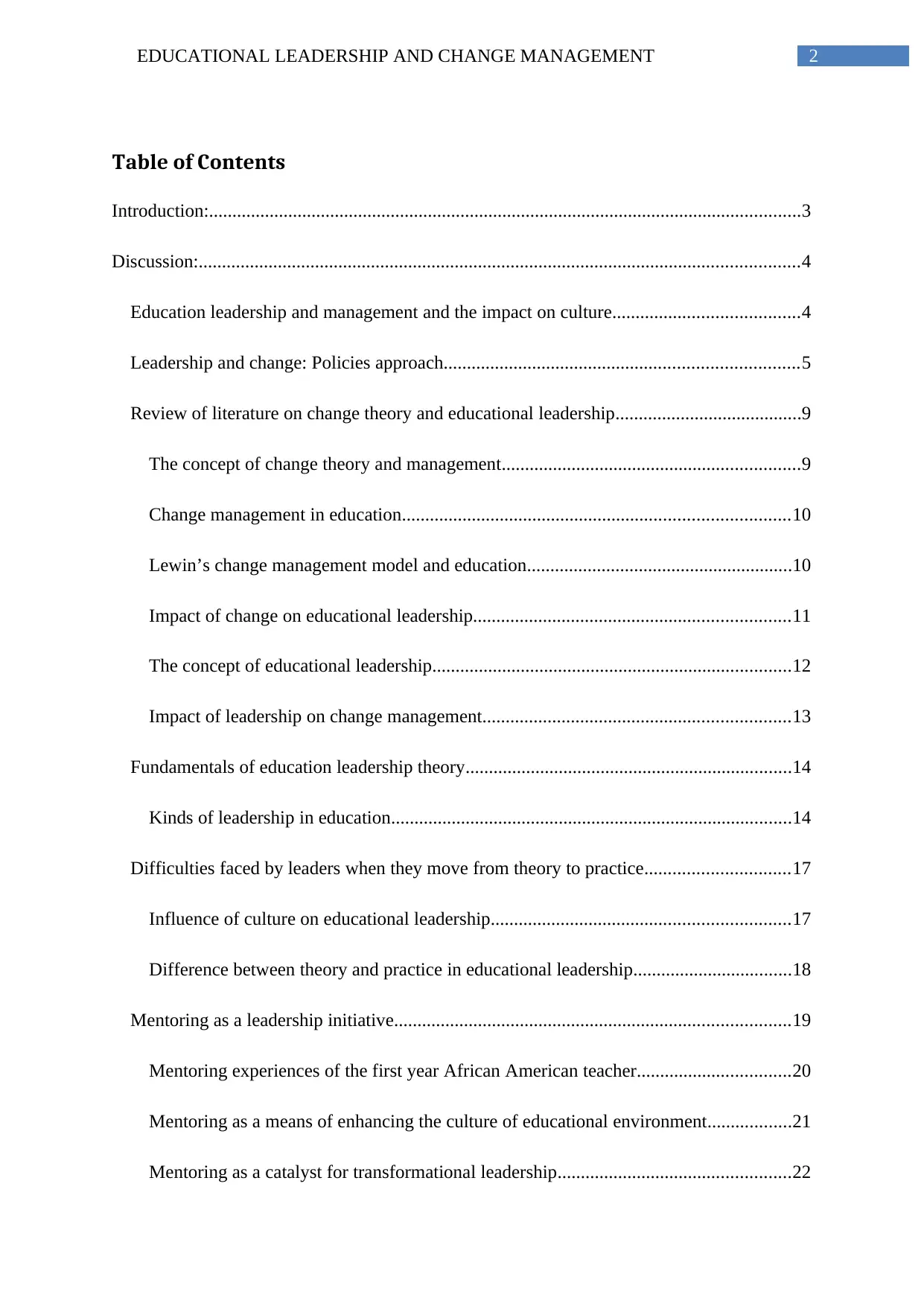
2EDUCATIONAL LEADERSHIP AND CHANGE MANAGEMENT
Table of Contents
Introduction:...............................................................................................................................3
Discussion:.................................................................................................................................4
Education leadership and management and the impact on culture........................................4
Leadership and change: Policies approach............................................................................5
Review of literature on change theory and educational leadership........................................9
The concept of change theory and management................................................................9
Change management in education...................................................................................10
Lewin’s change management model and education.........................................................10
Impact of change on educational leadership....................................................................11
The concept of educational leadership.............................................................................12
Impact of leadership on change management..................................................................13
Fundamentals of education leadership theory......................................................................14
Kinds of leadership in education......................................................................................14
Difficulties faced by leaders when they move from theory to practice...............................17
Influence of culture on educational leadership................................................................17
Difference between theory and practice in educational leadership..................................18
Mentoring as a leadership initiative.....................................................................................19
Mentoring experiences of the first year African American teacher.................................20
Mentoring as a means of enhancing the culture of educational environment..................21
Mentoring as a catalyst for transformational leadership..................................................22
Table of Contents
Introduction:...............................................................................................................................3
Discussion:.................................................................................................................................4
Education leadership and management and the impact on culture........................................4
Leadership and change: Policies approach............................................................................5
Review of literature on change theory and educational leadership........................................9
The concept of change theory and management................................................................9
Change management in education...................................................................................10
Lewin’s change management model and education.........................................................10
Impact of change on educational leadership....................................................................11
The concept of educational leadership.............................................................................12
Impact of leadership on change management..................................................................13
Fundamentals of education leadership theory......................................................................14
Kinds of leadership in education......................................................................................14
Difficulties faced by leaders when they move from theory to practice...............................17
Influence of culture on educational leadership................................................................17
Difference between theory and practice in educational leadership..................................18
Mentoring as a leadership initiative.....................................................................................19
Mentoring experiences of the first year African American teacher.................................20
Mentoring as a means of enhancing the culture of educational environment..................21
Mentoring as a catalyst for transformational leadership..................................................22
⊘ This is a preview!⊘
Do you want full access?
Subscribe today to unlock all pages.

Trusted by 1+ million students worldwide
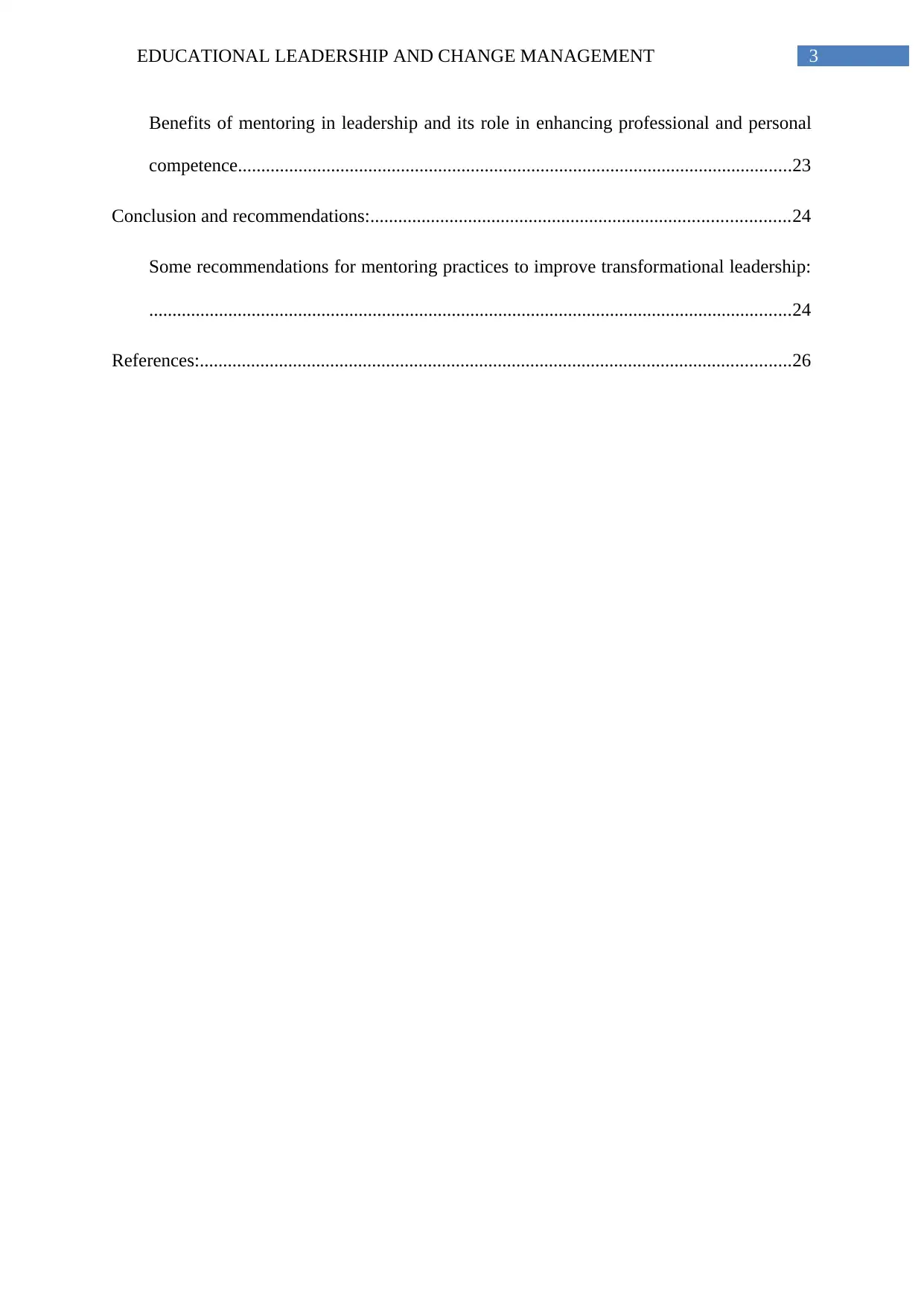
3EDUCATIONAL LEADERSHIP AND CHANGE MANAGEMENT
Benefits of mentoring in leadership and its role in enhancing professional and personal
competence.......................................................................................................................23
Conclusion and recommendations:..........................................................................................24
Some recommendations for mentoring practices to improve transformational leadership:
..........................................................................................................................................24
References:...............................................................................................................................26
Benefits of mentoring in leadership and its role in enhancing professional and personal
competence.......................................................................................................................23
Conclusion and recommendations:..........................................................................................24
Some recommendations for mentoring practices to improve transformational leadership:
..........................................................................................................................................24
References:...............................................................................................................................26
Paraphrase This Document
Need a fresh take? Get an instant paraphrase of this document with our AI Paraphraser
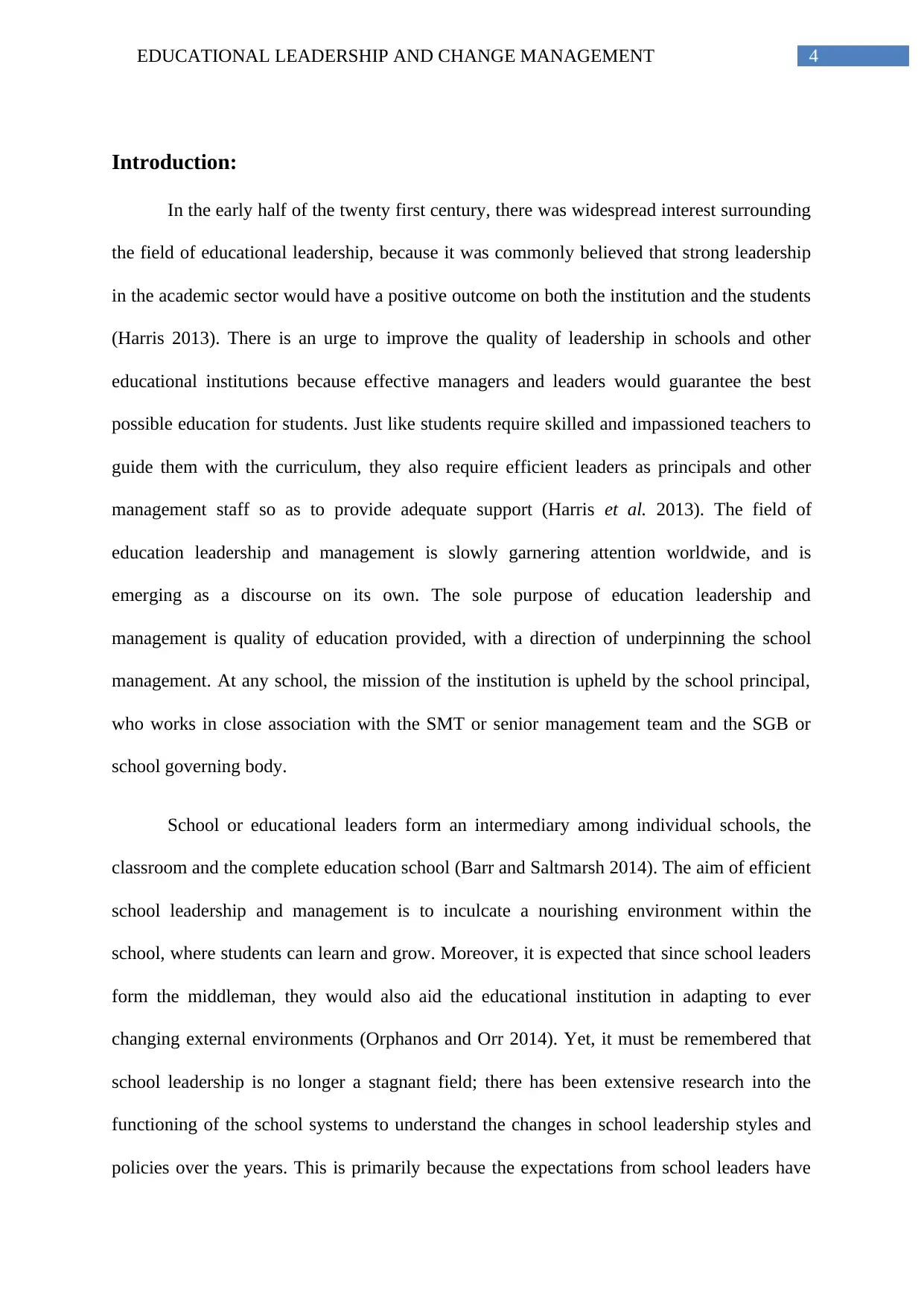
4EDUCATIONAL LEADERSHIP AND CHANGE MANAGEMENT
Introduction:
In the early half of the twenty first century, there was widespread interest surrounding
the field of educational leadership, because it was commonly believed that strong leadership
in the academic sector would have a positive outcome on both the institution and the students
(Harris 2013). There is an urge to improve the quality of leadership in schools and other
educational institutions because effective managers and leaders would guarantee the best
possible education for students. Just like students require skilled and impassioned teachers to
guide them with the curriculum, they also require efficient leaders as principals and other
management staff so as to provide adequate support (Harris et al. 2013). The field of
education leadership and management is slowly garnering attention worldwide, and is
emerging as a discourse on its own. The sole purpose of education leadership and
management is quality of education provided, with a direction of underpinning the school
management. At any school, the mission of the institution is upheld by the school principal,
who works in close association with the SMT or senior management team and the SGB or
school governing body.
School or educational leaders form an intermediary among individual schools, the
classroom and the complete education school (Barr and Saltmarsh 2014). The aim of efficient
school leadership and management is to inculcate a nourishing environment within the
school, where students can learn and grow. Moreover, it is expected that since school leaders
form the middleman, they would also aid the educational institution in adapting to ever
changing external environments (Orphanos and Orr 2014). Yet, it must be remembered that
school leadership is no longer a stagnant field; there has been extensive research into the
functioning of the school systems to understand the changes in school leadership styles and
policies over the years. This is primarily because the expectations from school leaders have
Introduction:
In the early half of the twenty first century, there was widespread interest surrounding
the field of educational leadership, because it was commonly believed that strong leadership
in the academic sector would have a positive outcome on both the institution and the students
(Harris 2013). There is an urge to improve the quality of leadership in schools and other
educational institutions because effective managers and leaders would guarantee the best
possible education for students. Just like students require skilled and impassioned teachers to
guide them with the curriculum, they also require efficient leaders as principals and other
management staff so as to provide adequate support (Harris et al. 2013). The field of
education leadership and management is slowly garnering attention worldwide, and is
emerging as a discourse on its own. The sole purpose of education leadership and
management is quality of education provided, with a direction of underpinning the school
management. At any school, the mission of the institution is upheld by the school principal,
who works in close association with the SMT or senior management team and the SGB or
school governing body.
School or educational leaders form an intermediary among individual schools, the
classroom and the complete education school (Barr and Saltmarsh 2014). The aim of efficient
school leadership and management is to inculcate a nourishing environment within the
school, where students can learn and grow. Moreover, it is expected that since school leaders
form the middleman, they would also aid the educational institution in adapting to ever
changing external environments (Orphanos and Orr 2014). Yet, it must be remembered that
school leadership is no longer a stagnant field; there has been extensive research into the
functioning of the school systems to understand the changes in school leadership styles and
policies over the years. This is primarily because the expectations from school leaders have
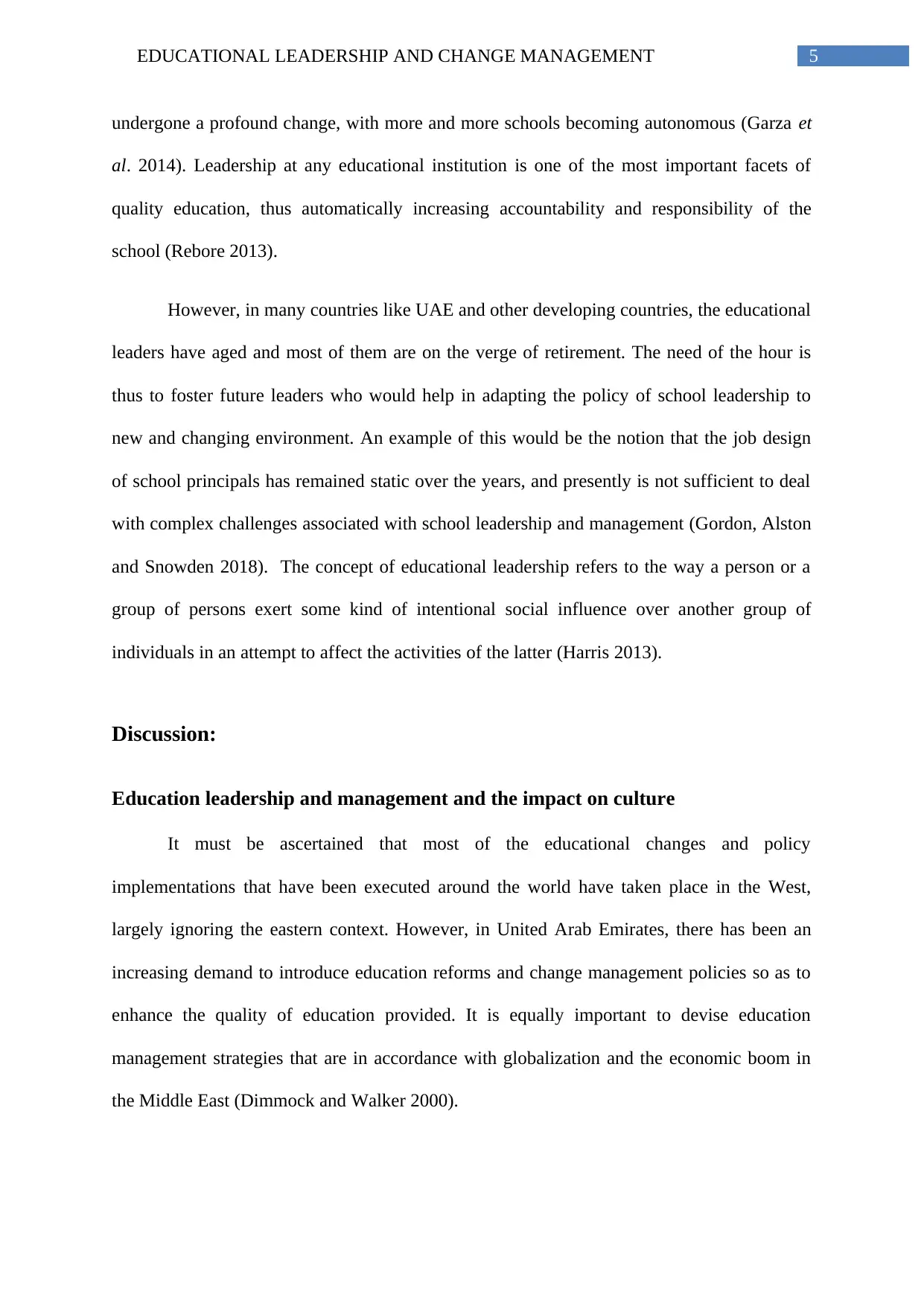
5EDUCATIONAL LEADERSHIP AND CHANGE MANAGEMENT
undergone a profound change, with more and more schools becoming autonomous (Garza et
al. 2014). Leadership at any educational institution is one of the most important facets of
quality education, thus automatically increasing accountability and responsibility of the
school (Rebore 2013).
However, in many countries like UAE and other developing countries, the educational
leaders have aged and most of them are on the verge of retirement. The need of the hour is
thus to foster future leaders who would help in adapting the policy of school leadership to
new and changing environment. An example of this would be the notion that the job design
of school principals has remained static over the years, and presently is not sufficient to deal
with complex challenges associated with school leadership and management (Gordon, Alston
and Snowden 2018). The concept of educational leadership refers to the way a person or a
group of persons exert some kind of intentional social influence over another group of
individuals in an attempt to affect the activities of the latter (Harris 2013).
Discussion:
Education leadership and management and the impact on culture
It must be ascertained that most of the educational changes and policy
implementations that have been executed around the world have taken place in the West,
largely ignoring the eastern context. However, in United Arab Emirates, there has been an
increasing demand to introduce education reforms and change management policies so as to
enhance the quality of education provided. It is equally important to devise education
management strategies that are in accordance with globalization and the economic boom in
the Middle East (Dimmock and Walker 2000).
undergone a profound change, with more and more schools becoming autonomous (Garza et
al. 2014). Leadership at any educational institution is one of the most important facets of
quality education, thus automatically increasing accountability and responsibility of the
school (Rebore 2013).
However, in many countries like UAE and other developing countries, the educational
leaders have aged and most of them are on the verge of retirement. The need of the hour is
thus to foster future leaders who would help in adapting the policy of school leadership to
new and changing environment. An example of this would be the notion that the job design
of school principals has remained static over the years, and presently is not sufficient to deal
with complex challenges associated with school leadership and management (Gordon, Alston
and Snowden 2018). The concept of educational leadership refers to the way a person or a
group of persons exert some kind of intentional social influence over another group of
individuals in an attempt to affect the activities of the latter (Harris 2013).
Discussion:
Education leadership and management and the impact on culture
It must be ascertained that most of the educational changes and policy
implementations that have been executed around the world have taken place in the West,
largely ignoring the eastern context. However, in United Arab Emirates, there has been an
increasing demand to introduce education reforms and change management policies so as to
enhance the quality of education provided. It is equally important to devise education
management strategies that are in accordance with globalization and the economic boom in
the Middle East (Dimmock and Walker 2000).
⊘ This is a preview!⊘
Do you want full access?
Subscribe today to unlock all pages.

Trusted by 1+ million students worldwide
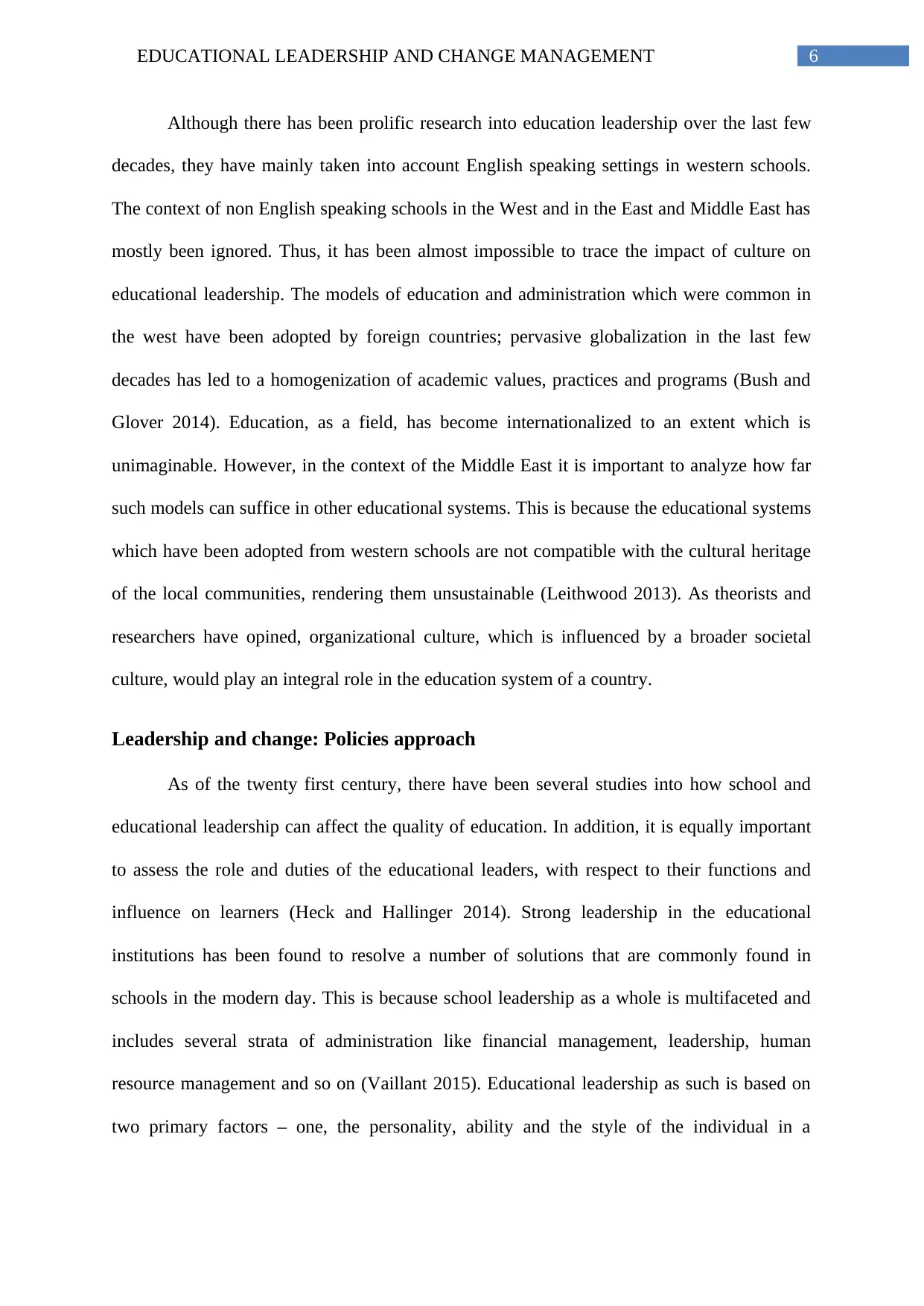
6EDUCATIONAL LEADERSHIP AND CHANGE MANAGEMENT
Although there has been prolific research into education leadership over the last few
decades, they have mainly taken into account English speaking settings in western schools.
The context of non English speaking schools in the West and in the East and Middle East has
mostly been ignored. Thus, it has been almost impossible to trace the impact of culture on
educational leadership. The models of education and administration which were common in
the west have been adopted by foreign countries; pervasive globalization in the last few
decades has led to a homogenization of academic values, practices and programs (Bush and
Glover 2014). Education, as a field, has become internationalized to an extent which is
unimaginable. However, in the context of the Middle East it is important to analyze how far
such models can suffice in other educational systems. This is because the educational systems
which have been adopted from western schools are not compatible with the cultural heritage
of the local communities, rendering them unsustainable (Leithwood 2013). As theorists and
researchers have opined, organizational culture, which is influenced by a broader societal
culture, would play an integral role in the education system of a country.
Leadership and change: Policies approach
As of the twenty first century, there have been several studies into how school and
educational leadership can affect the quality of education. In addition, it is equally important
to assess the role and duties of the educational leaders, with respect to their functions and
influence on learners (Heck and Hallinger 2014). Strong leadership in the educational
institutions has been found to resolve a number of solutions that are commonly found in
schools in the modern day. This is because school leadership as a whole is multifaceted and
includes several strata of administration like financial management, leadership, human
resource management and so on (Vaillant 2015). Educational leadership as such is based on
two primary factors – one, the personality, ability and the style of the individual in a
Although there has been prolific research into education leadership over the last few
decades, they have mainly taken into account English speaking settings in western schools.
The context of non English speaking schools in the West and in the East and Middle East has
mostly been ignored. Thus, it has been almost impossible to trace the impact of culture on
educational leadership. The models of education and administration which were common in
the west have been adopted by foreign countries; pervasive globalization in the last few
decades has led to a homogenization of academic values, practices and programs (Bush and
Glover 2014). Education, as a field, has become internationalized to an extent which is
unimaginable. However, in the context of the Middle East it is important to analyze how far
such models can suffice in other educational systems. This is because the educational systems
which have been adopted from western schools are not compatible with the cultural heritage
of the local communities, rendering them unsustainable (Leithwood 2013). As theorists and
researchers have opined, organizational culture, which is influenced by a broader societal
culture, would play an integral role in the education system of a country.
Leadership and change: Policies approach
As of the twenty first century, there have been several studies into how school and
educational leadership can affect the quality of education. In addition, it is equally important
to assess the role and duties of the educational leaders, with respect to their functions and
influence on learners (Heck and Hallinger 2014). Strong leadership in the educational
institutions has been found to resolve a number of solutions that are commonly found in
schools in the modern day. This is because school leadership as a whole is multifaceted and
includes several strata of administration like financial management, leadership, human
resource management and so on (Vaillant 2015). Educational leadership as such is based on
two primary factors – one, the personality, ability and the style of the individual in a
Paraphrase This Document
Need a fresh take? Get an instant paraphrase of this document with our AI Paraphraser
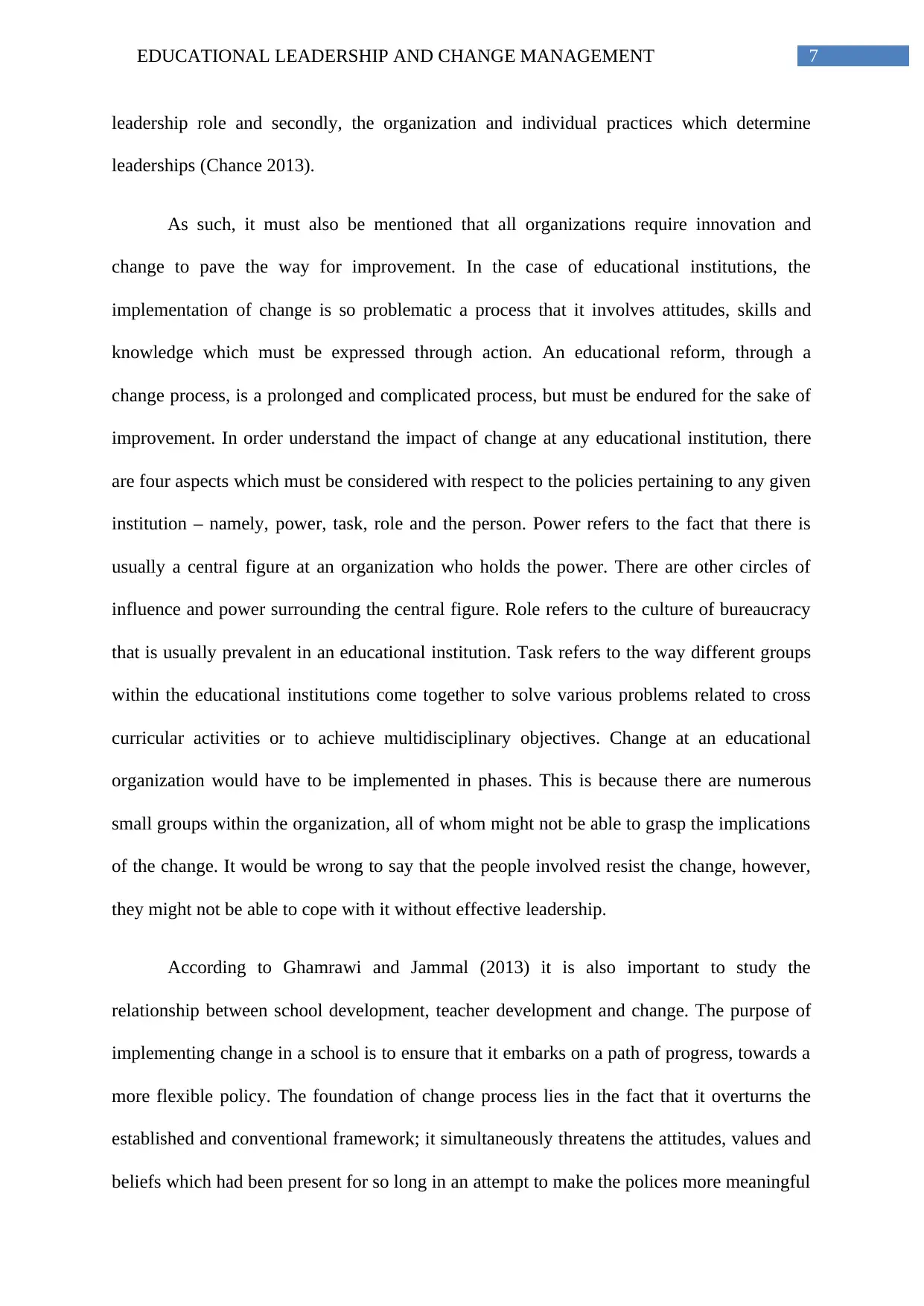
7EDUCATIONAL LEADERSHIP AND CHANGE MANAGEMENT
leadership role and secondly, the organization and individual practices which determine
leaderships (Chance 2013).
As such, it must also be mentioned that all organizations require innovation and
change to pave the way for improvement. In the case of educational institutions, the
implementation of change is so problematic a process that it involves attitudes, skills and
knowledge which must be expressed through action. An educational reform, through a
change process, is a prolonged and complicated process, but must be endured for the sake of
improvement. In order understand the impact of change at any educational institution, there
are four aspects which must be considered with respect to the policies pertaining to any given
institution – namely, power, task, role and the person. Power refers to the fact that there is
usually a central figure at an organization who holds the power. There are other circles of
influence and power surrounding the central figure. Role refers to the culture of bureaucracy
that is usually prevalent in an educational institution. Task refers to the way different groups
within the educational institutions come together to solve various problems related to cross
curricular activities or to achieve multidisciplinary objectives. Change at an educational
organization would have to be implemented in phases. This is because there are numerous
small groups within the organization, all of whom might not be able to grasp the implications
of the change. It would be wrong to say that the people involved resist the change, however,
they might not be able to cope with it without effective leadership.
According to Ghamrawi and Jammal (2013) it is also important to study the
relationship between school development, teacher development and change. The purpose of
implementing change in a school is to ensure that it embarks on a path of progress, towards a
more flexible policy. The foundation of change process lies in the fact that it overturns the
established and conventional framework; it simultaneously threatens the attitudes, values and
beliefs which had been present for so long in an attempt to make the polices more meaningful
leadership role and secondly, the organization and individual practices which determine
leaderships (Chance 2013).
As such, it must also be mentioned that all organizations require innovation and
change to pave the way for improvement. In the case of educational institutions, the
implementation of change is so problematic a process that it involves attitudes, skills and
knowledge which must be expressed through action. An educational reform, through a
change process, is a prolonged and complicated process, but must be endured for the sake of
improvement. In order understand the impact of change at any educational institution, there
are four aspects which must be considered with respect to the policies pertaining to any given
institution – namely, power, task, role and the person. Power refers to the fact that there is
usually a central figure at an organization who holds the power. There are other circles of
influence and power surrounding the central figure. Role refers to the culture of bureaucracy
that is usually prevalent in an educational institution. Task refers to the way different groups
within the educational institutions come together to solve various problems related to cross
curricular activities or to achieve multidisciplinary objectives. Change at an educational
organization would have to be implemented in phases. This is because there are numerous
small groups within the organization, all of whom might not be able to grasp the implications
of the change. It would be wrong to say that the people involved resist the change, however,
they might not be able to cope with it without effective leadership.
According to Ghamrawi and Jammal (2013) it is also important to study the
relationship between school development, teacher development and change. The purpose of
implementing change in a school is to ensure that it embarks on a path of progress, towards a
more flexible policy. The foundation of change process lies in the fact that it overturns the
established and conventional framework; it simultaneously threatens the attitudes, values and
beliefs which had been present for so long in an attempt to make the polices more meaningful
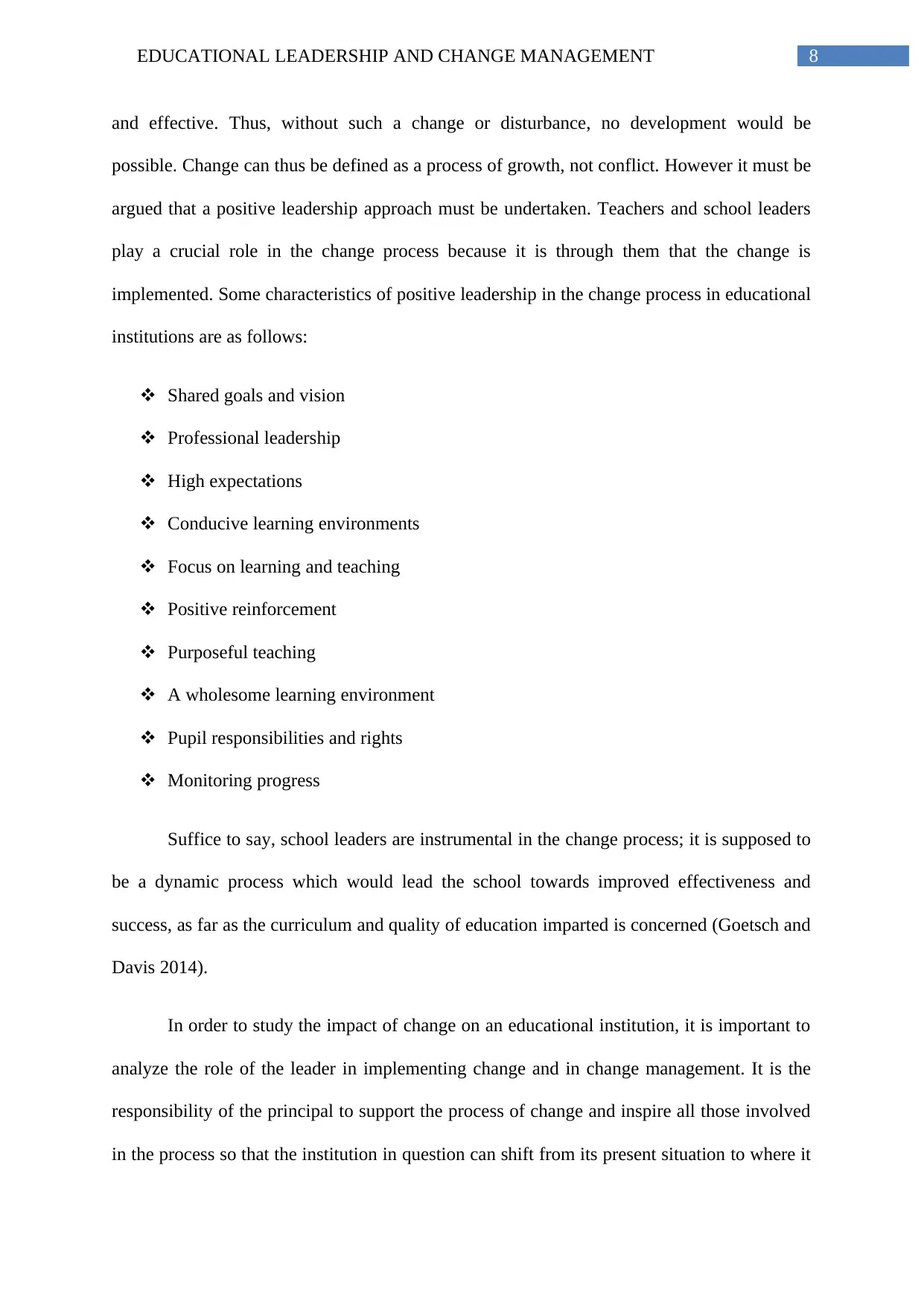
8EDUCATIONAL LEADERSHIP AND CHANGE MANAGEMENT
and effective. Thus, without such a change or disturbance, no development would be
possible. Change can thus be defined as a process of growth, not conflict. However it must be
argued that a positive leadership approach must be undertaken. Teachers and school leaders
play a crucial role in the change process because it is through them that the change is
implemented. Some characteristics of positive leadership in the change process in educational
institutions are as follows:
Shared goals and vision
Professional leadership
High expectations
Conducive learning environments
Focus on learning and teaching
Positive reinforcement
Purposeful teaching
A wholesome learning environment
Pupil responsibilities and rights
Monitoring progress
Suffice to say, school leaders are instrumental in the change process; it is supposed to
be a dynamic process which would lead the school towards improved effectiveness and
success, as far as the curriculum and quality of education imparted is concerned (Goetsch and
Davis 2014).
In order to study the impact of change on an educational institution, it is important to
analyze the role of the leader in implementing change and in change management. It is the
responsibility of the principal to support the process of change and inspire all those involved
in the process so that the institution in question can shift from its present situation to where it
and effective. Thus, without such a change or disturbance, no development would be
possible. Change can thus be defined as a process of growth, not conflict. However it must be
argued that a positive leadership approach must be undertaken. Teachers and school leaders
play a crucial role in the change process because it is through them that the change is
implemented. Some characteristics of positive leadership in the change process in educational
institutions are as follows:
Shared goals and vision
Professional leadership
High expectations
Conducive learning environments
Focus on learning and teaching
Positive reinforcement
Purposeful teaching
A wholesome learning environment
Pupil responsibilities and rights
Monitoring progress
Suffice to say, school leaders are instrumental in the change process; it is supposed to
be a dynamic process which would lead the school towards improved effectiveness and
success, as far as the curriculum and quality of education imparted is concerned (Goetsch and
Davis 2014).
In order to study the impact of change on an educational institution, it is important to
analyze the role of the leader in implementing change and in change management. It is the
responsibility of the principal to support the process of change and inspire all those involved
in the process so that the institution in question can shift from its present situation to where it
⊘ This is a preview!⊘
Do you want full access?
Subscribe today to unlock all pages.

Trusted by 1+ million students worldwide
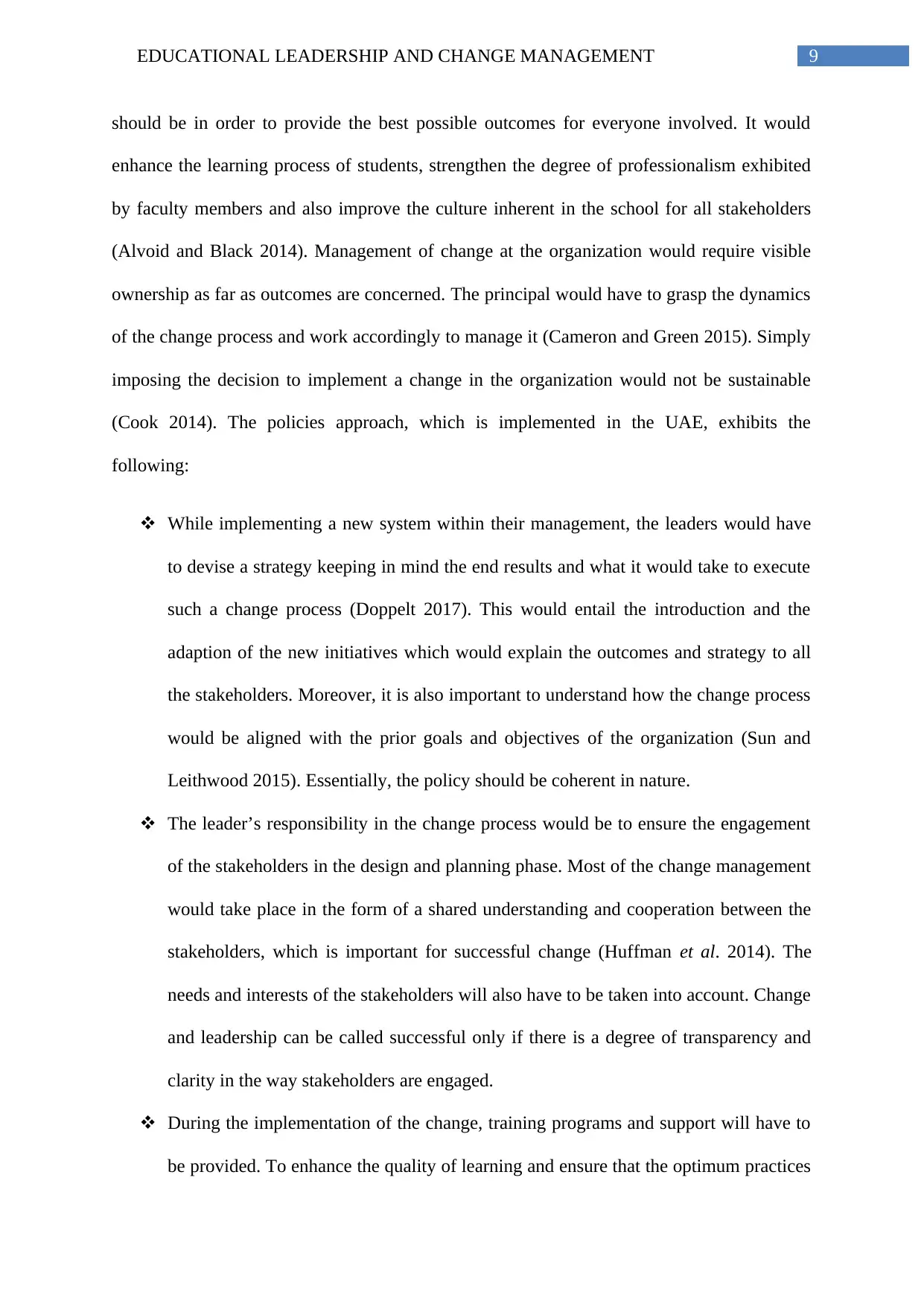
9EDUCATIONAL LEADERSHIP AND CHANGE MANAGEMENT
should be in order to provide the best possible outcomes for everyone involved. It would
enhance the learning process of students, strengthen the degree of professionalism exhibited
by faculty members and also improve the culture inherent in the school for all stakeholders
(Alvoid and Black 2014). Management of change at the organization would require visible
ownership as far as outcomes are concerned. The principal would have to grasp the dynamics
of the change process and work accordingly to manage it (Cameron and Green 2015). Simply
imposing the decision to implement a change in the organization would not be sustainable
(Cook 2014). The policies approach, which is implemented in the UAE, exhibits the
following:
While implementing a new system within their management, the leaders would have
to devise a strategy keeping in mind the end results and what it would take to execute
such a change process (Doppelt 2017). This would entail the introduction and the
adaption of the new initiatives which would explain the outcomes and strategy to all
the stakeholders. Moreover, it is also important to understand how the change process
would be aligned with the prior goals and objectives of the organization (Sun and
Leithwood 2015). Essentially, the policy should be coherent in nature.
The leader’s responsibility in the change process would be to ensure the engagement
of the stakeholders in the design and planning phase. Most of the change management
would take place in the form of a shared understanding and cooperation between the
stakeholders, which is important for successful change (Huffman et al. 2014). The
needs and interests of the stakeholders will also have to be taken into account. Change
and leadership can be called successful only if there is a degree of transparency and
clarity in the way stakeholders are engaged.
During the implementation of the change, training programs and support will have to
be provided. To enhance the quality of learning and ensure that the optimum practices
should be in order to provide the best possible outcomes for everyone involved. It would
enhance the learning process of students, strengthen the degree of professionalism exhibited
by faculty members and also improve the culture inherent in the school for all stakeholders
(Alvoid and Black 2014). Management of change at the organization would require visible
ownership as far as outcomes are concerned. The principal would have to grasp the dynamics
of the change process and work accordingly to manage it (Cameron and Green 2015). Simply
imposing the decision to implement a change in the organization would not be sustainable
(Cook 2014). The policies approach, which is implemented in the UAE, exhibits the
following:
While implementing a new system within their management, the leaders would have
to devise a strategy keeping in mind the end results and what it would take to execute
such a change process (Doppelt 2017). This would entail the introduction and the
adaption of the new initiatives which would explain the outcomes and strategy to all
the stakeholders. Moreover, it is also important to understand how the change process
would be aligned with the prior goals and objectives of the organization (Sun and
Leithwood 2015). Essentially, the policy should be coherent in nature.
The leader’s responsibility in the change process would be to ensure the engagement
of the stakeholders in the design and planning phase. Most of the change management
would take place in the form of a shared understanding and cooperation between the
stakeholders, which is important for successful change (Huffman et al. 2014). The
needs and interests of the stakeholders will also have to be taken into account. Change
and leadership can be called successful only if there is a degree of transparency and
clarity in the way stakeholders are engaged.
During the implementation of the change, training programs and support will have to
be provided. To enhance the quality of learning and ensure that the optimum practices
Paraphrase This Document
Need a fresh take? Get an instant paraphrase of this document with our AI Paraphraser
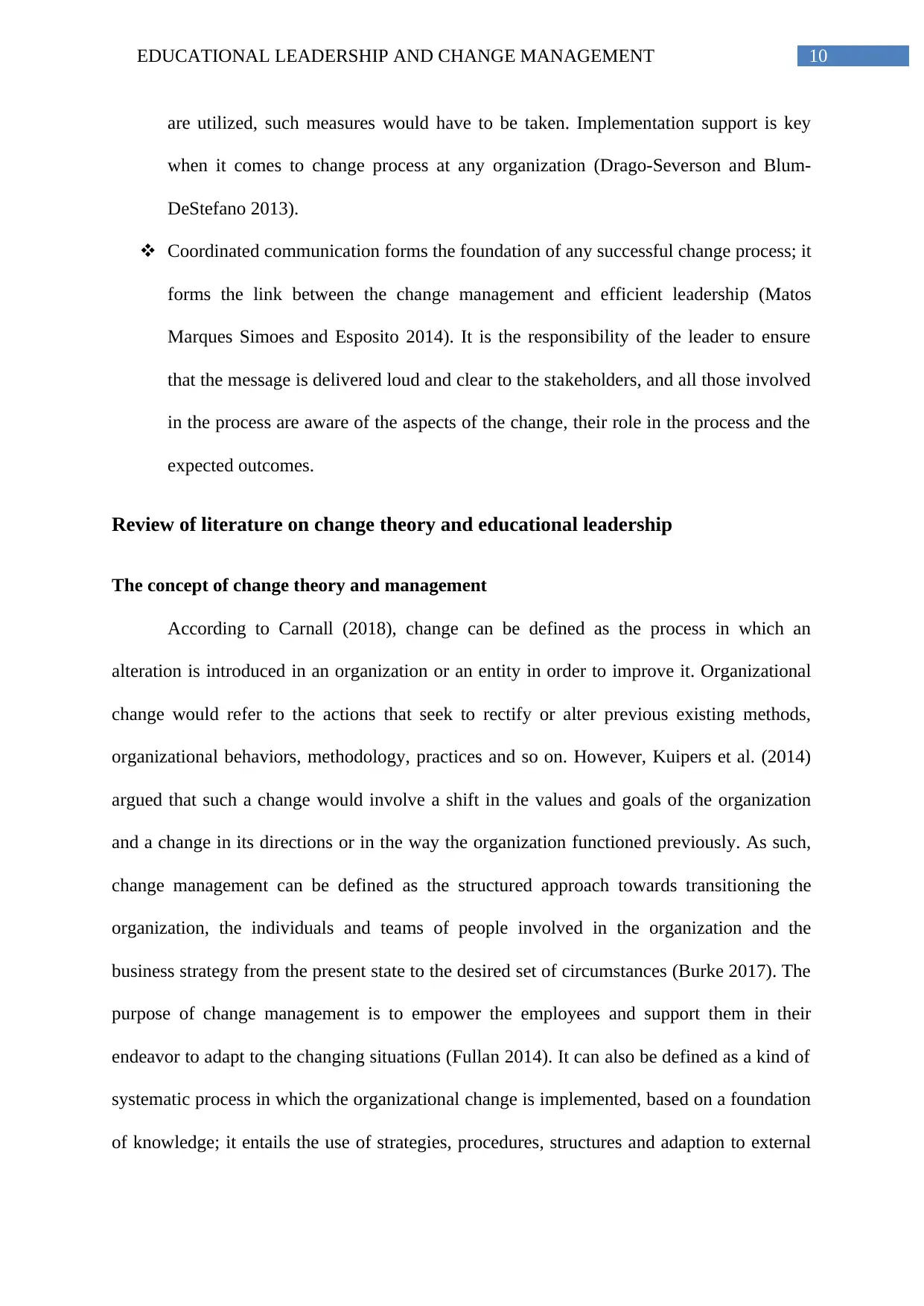
10EDUCATIONAL LEADERSHIP AND CHANGE MANAGEMENT
are utilized, such measures would have to be taken. Implementation support is key
when it comes to change process at any organization (Drago-Severson and Blum-
DeStefano 2013).
Coordinated communication forms the foundation of any successful change process; it
forms the link between the change management and efficient leadership (Matos
Marques Simoes and Esposito 2014). It is the responsibility of the leader to ensure
that the message is delivered loud and clear to the stakeholders, and all those involved
in the process are aware of the aspects of the change, their role in the process and the
expected outcomes.
Review of literature on change theory and educational leadership
The concept of change theory and management
According to Carnall (2018), change can be defined as the process in which an
alteration is introduced in an organization or an entity in order to improve it. Organizational
change would refer to the actions that seek to rectify or alter previous existing methods,
organizational behaviors, methodology, practices and so on. However, Kuipers et al. (2014)
argued that such a change would involve a shift in the values and goals of the organization
and a change in its directions or in the way the organization functioned previously. As such,
change management can be defined as the structured approach towards transitioning the
organization, the individuals and teams of people involved in the organization and the
business strategy from the present state to the desired set of circumstances (Burke 2017). The
purpose of change management is to empower the employees and support them in their
endeavor to adapt to the changing situations (Fullan 2014). It can also be defined as a kind of
systematic process in which the organizational change is implemented, based on a foundation
of knowledge; it entails the use of strategies, procedures, structures and adaption to external
are utilized, such measures would have to be taken. Implementation support is key
when it comes to change process at any organization (Drago-Severson and Blum-
DeStefano 2013).
Coordinated communication forms the foundation of any successful change process; it
forms the link between the change management and efficient leadership (Matos
Marques Simoes and Esposito 2014). It is the responsibility of the leader to ensure
that the message is delivered loud and clear to the stakeholders, and all those involved
in the process are aware of the aspects of the change, their role in the process and the
expected outcomes.
Review of literature on change theory and educational leadership
The concept of change theory and management
According to Carnall (2018), change can be defined as the process in which an
alteration is introduced in an organization or an entity in order to improve it. Organizational
change would refer to the actions that seek to rectify or alter previous existing methods,
organizational behaviors, methodology, practices and so on. However, Kuipers et al. (2014)
argued that such a change would involve a shift in the values and goals of the organization
and a change in its directions or in the way the organization functioned previously. As such,
change management can be defined as the structured approach towards transitioning the
organization, the individuals and teams of people involved in the organization and the
business strategy from the present state to the desired set of circumstances (Burke 2017). The
purpose of change management is to empower the employees and support them in their
endeavor to adapt to the changing situations (Fullan 2014). It can also be defined as a kind of
systematic process in which the organizational change is implemented, based on a foundation
of knowledge; it entails the use of strategies, procedures, structures and adaption to external
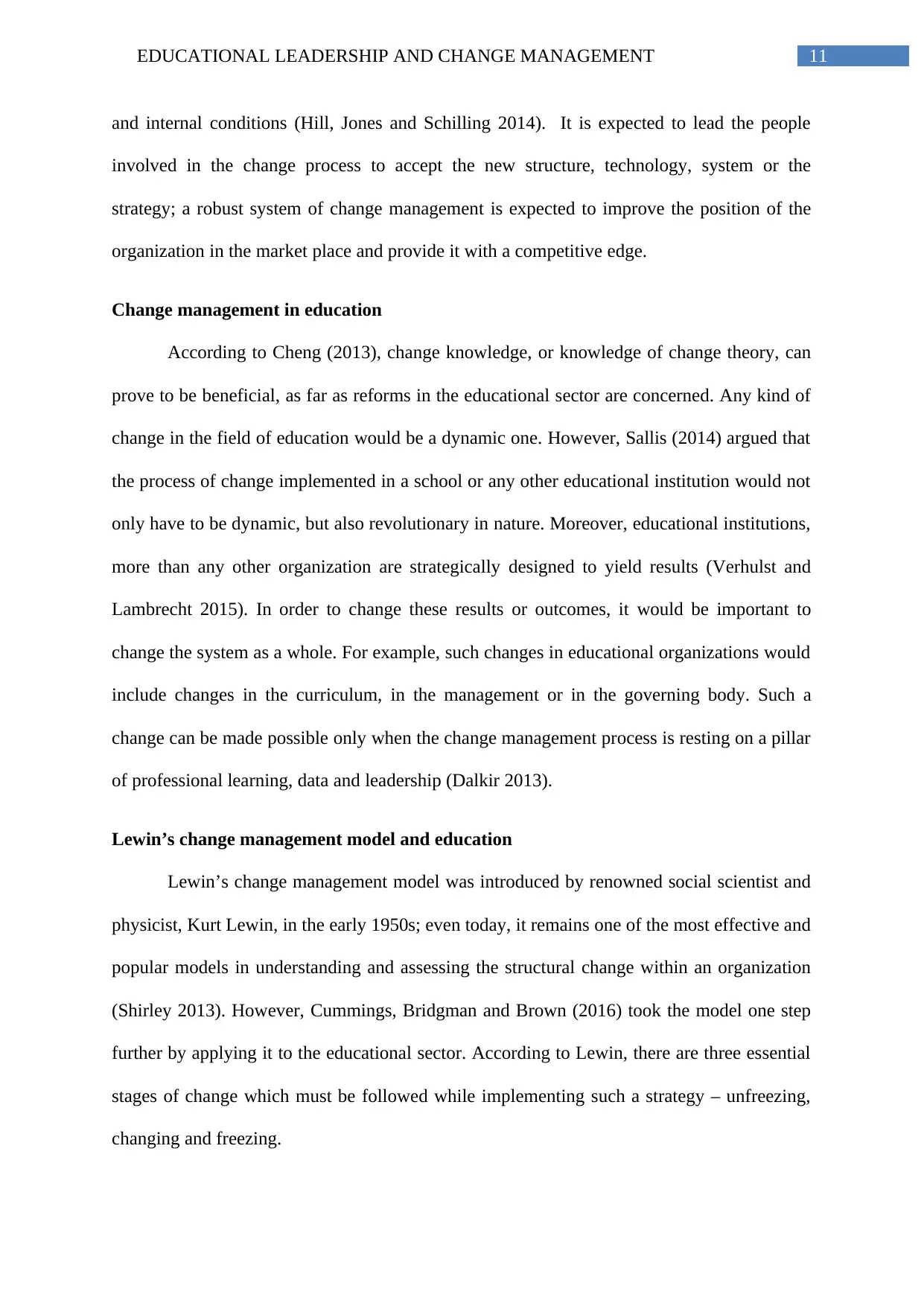
11EDUCATIONAL LEADERSHIP AND CHANGE MANAGEMENT
and internal conditions (Hill, Jones and Schilling 2014). It is expected to lead the people
involved in the change process to accept the new structure, technology, system or the
strategy; a robust system of change management is expected to improve the position of the
organization in the market place and provide it with a competitive edge.
Change management in education
According to Cheng (2013), change knowledge, or knowledge of change theory, can
prove to be beneficial, as far as reforms in the educational sector are concerned. Any kind of
change in the field of education would be a dynamic one. However, Sallis (2014) argued that
the process of change implemented in a school or any other educational institution would not
only have to be dynamic, but also revolutionary in nature. Moreover, educational institutions,
more than any other organization are strategically designed to yield results (Verhulst and
Lambrecht 2015). In order to change these results or outcomes, it would be important to
change the system as a whole. For example, such changes in educational organizations would
include changes in the curriculum, in the management or in the governing body. Such a
change can be made possible only when the change management process is resting on a pillar
of professional learning, data and leadership (Dalkir 2013).
Lewin’s change management model and education
Lewin’s change management model was introduced by renowned social scientist and
physicist, Kurt Lewin, in the early 1950s; even today, it remains one of the most effective and
popular models in understanding and assessing the structural change within an organization
(Shirley 2013). However, Cummings, Bridgman and Brown (2016) took the model one step
further by applying it to the educational sector. According to Lewin, there are three essential
stages of change which must be followed while implementing such a strategy – unfreezing,
changing and freezing.
and internal conditions (Hill, Jones and Schilling 2014). It is expected to lead the people
involved in the change process to accept the new structure, technology, system or the
strategy; a robust system of change management is expected to improve the position of the
organization in the market place and provide it with a competitive edge.
Change management in education
According to Cheng (2013), change knowledge, or knowledge of change theory, can
prove to be beneficial, as far as reforms in the educational sector are concerned. Any kind of
change in the field of education would be a dynamic one. However, Sallis (2014) argued that
the process of change implemented in a school or any other educational institution would not
only have to be dynamic, but also revolutionary in nature. Moreover, educational institutions,
more than any other organization are strategically designed to yield results (Verhulst and
Lambrecht 2015). In order to change these results or outcomes, it would be important to
change the system as a whole. For example, such changes in educational organizations would
include changes in the curriculum, in the management or in the governing body. Such a
change can be made possible only when the change management process is resting on a pillar
of professional learning, data and leadership (Dalkir 2013).
Lewin’s change management model and education
Lewin’s change management model was introduced by renowned social scientist and
physicist, Kurt Lewin, in the early 1950s; even today, it remains one of the most effective and
popular models in understanding and assessing the structural change within an organization
(Shirley 2013). However, Cummings, Bridgman and Brown (2016) took the model one step
further by applying it to the educational sector. According to Lewin, there are three essential
stages of change which must be followed while implementing such a strategy – unfreezing,
changing and freezing.
⊘ This is a preview!⊘
Do you want full access?
Subscribe today to unlock all pages.

Trusted by 1+ million students worldwide
1 out of 34
Related Documents
Your All-in-One AI-Powered Toolkit for Academic Success.
+13062052269
info@desklib.com
Available 24*7 on WhatsApp / Email
![[object Object]](/_next/static/media/star-bottom.7253800d.svg)
Unlock your academic potential
Copyright © 2020–2025 A2Z Services. All Rights Reserved. Developed and managed by ZUCOL.





